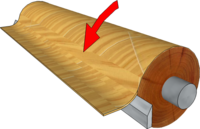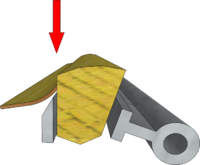Veneer: Difference between revisions
From DT Online
mNo edit summary |
m (Added Category) |
||
| (2 intermediate revisions by the same user not shown) | |||
| Line 24: | Line 24: | ||
|- | |- | ||
| '''Rift Cut Veneers''' | | '''Rift Cut Veneers''' | ||
| This process produces straight grain veneers with a narrow striped pattern. The logs are first '''[[Timber Conversion|Quarter Sawn]]''' and a segment fixed to a table on a lathe type machine such that slicing occurs | | This process produces straight grain veneers with a narrow striped pattern. The logs are first '''[[Timber Conversion|Quarter Sawn]]''' and a segment fixed to a table on a lathe type machine such that slicing occurs across the lines of the [https://en.wikipedia.org/wiki/Dendrochronology#Growth_rings '''Annular Rings''']. The sections of timber for this and other veneer cutting processes are known as '''Flitches'''. Before use they are steamed or soaked in hot water to ease cutting, | ||
| [[File:RiftCut.png|200px|right]] | | [[File:RiftCut.png|200px|right]] | ||
|- | |- | ||
| Line 36: | Line 36: | ||
[[Category:Materials and Components]] | |||
[[Category:Timber]] | |||
[[Category:Terminology]] | [[Category:Terminology]] | ||
Latest revision as of 13:56, 4 January 2018
Description
Veneers are thin slices of wood which are glued on to the surface of a core material for decorative effect or Laminated to each other to create Plywood. Veneers can also be glued together around Moulds to create curved forms.
Production Methods
In addition to the production of Plywood and Cold Moulding, Veneers can be used as a means of preserving exotic or rare timber species by enabling the use of a single log to decorate a large number of products. The decorative effects are enhanced by the availability of veneers with almost identical grain patterns resulting from their being incrementally sliced from the same piece of timber. This feature is used to create various Veneering designs in which grain patterns are set against each other. Consecutive layers of Veneer are numbered and stacked together as they come off the machine to facilitate this use.
| Saw Cut Veneers | Using a saw to cut veneers is uneconomic since the wasted saw Kerf can be as wide as the veneer thickness so it is rarely done commercially. But it is a good way of making veneers from very brittle timbers or those with complex grain patterns. It is most used to produce the thicker veneers needed for Cold Moulding. | |
| Rotary Cut Veneer | Rotary cutting (or ‘Peeling’) is the most economic production method but the least effective for decorative work with exotic timbers. Complete logs of timber are roughly rounded then, after steaming or soaking in hot water, they are spun between centres and a sharp blade brought to bear along their length. The blade is geared such that each revolution it advances towards the centre of the log causing a continuous sheet of veneer to be ‘peeled’ off the log. The great majority of veneers are produced in this way and use extensively to manufacture plywood or provide a surface finish to sheets of MDF and chipboard for example. | |
| Rift Cut Veneers | This process produces straight grain veneers with a narrow striped pattern. The logs are first Quarter Sawn and a segment fixed to a table on a lathe type machine such that slicing occurs across the lines of the Annular Rings. The sections of timber for this and other veneer cutting processes are known as Flitches. Before use they are steamed or soaked in hot water to ease cutting, | |
| Knife Cut or Sliced Veneer | For Plain or Flat Sliced veneers a Flitch is fixed to a slide and cuts taken which are parallel to a line taken through the centre of the log. In Quarter Sliced veneers the logs are first Quarter Sawn and a segment fixed to a slide such that slices are taken perpendicular to the Annular Rings to reveal the Medullary Ray figure in Oak for example. |











